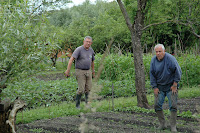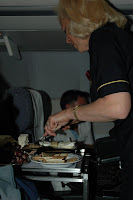90 minutes in paris

We arrived back at Paris Charles deGaulle Airport (CDG) at 3 p.m. to accommodate a travel writer colleague who had a late afternoon flight to Berlin. Writers invited on press trips often piggyback other destinations and stories... sort of a "while you're in the neighborhood" philosophy.
Since the remaining three writers had morning flights back to New York, San Francisco and Cleveland (moi!) we had a very welcome chunk of free time on the first really pleasant and sunny day we've seen this week. One writer elected to spend it chilling at the hotel until our 8 p.m. dinner reservation.
Having spent a week in Paris apartment with my daughter a few years ago, I know the city fairly well so hoped to catch the RER train from the airport into the city. I didn't want to spend an arm and leg for such a quick visit, but I couldn't be so close to one of my favorite cities without a least trying to reconnect. Since we were at the , Regular free buses shuttled continuous between the various hotels including our Airport Marriott and the airport with its ower level train station.
Another writer, Tom, and I set off at 4 p.m. and at the train station met our first glitch . The ticket dispensing machines refused to honor any of our credit cards and would take only coins for tickets. And of course there was no change machine.
After trying one machine after another we concluded that it was system wide problem. A long line of luggage laden visitors wound around the concourse to speak to two harried clerks. Neither of us spoke French so stopping a passerby probably wasn't a good option and we knew if we were to stand in line our Paris time would be gone. By then 45 minutes had elapsed.
We watched as a young women ahead of us at a ticket machine inserted her MasterCard and got her ticket in return. She overheard me say "I guess Paris just isn't in the cards" and turned to ask, in perfect English, if she could help. Delighted, we explained our problem. She watched as the same machine with a MasterCard icon rejected our cards again. "Why don't I just use my card and you can pay me for the tickets?" she suggested.
I could have hugged her. Two roundtrip tickets into the city & back totaled 16.80 euros (about $25) and soon we were on our way. She was headed to Munich, 90 minutes away, and we would have just about that amount of time in Paris.
The tickets work like those in London and other cities. Insert it upon entering the turnstile, pass through and reclaim it where it pops out the other side. We didn't want to have to go through the ticket purchase hassle another time so we guarded them with our lives.
Exiting the train at the central St.Michel we had several choices of underground walkways to take. I chose the Notre Dame one since Tom hadn't been to Paris in awhile and seeing the famous cathedral upon emerging from the subway is such a nice welcome. Like a lot of subway stations in the City of Light several flights of stairs interspersed with escalators were required to reach the surface. People with luggage exit at the Gare de Nord station with its elevators and connections to other lines in the vast Paris metro system.
Paris trains and subways are wonderfully efficient but I don't consider them a very good way to get from the airport into the city. Usually it's 1 to 2 a.m.Cleveland time when the overnight flight arrives into the Paris morning and most people, including me, are a little spaced out, to say the least. I usually take a bus into the city since they drop passengers off at centrally located spots within walking distance of a cab ride to central hotels. Last time though, my daughter had arranged a private car to take us directly to the apartment we'd rented. It cost about twice as much as the train, but was worth it to us since we didn't know where we were going and having to negotiate flights and flights of stairs with luggage is not my idea of a good time.
Tom and I enjoyed a lovely couple of sunny hours in Paris, stopped at a sidewalk cafe, shopped the stalls along the Seine and got a good dose of the French joie de vivre -- the very special, joyful French style engagement with life that is so energizing on a visit here. We got back to the hotel just in time to meet our colleague and enjoy our last bottle of Sancerre with a dinner of foie gras and asparagus.
 RSS
RSS













